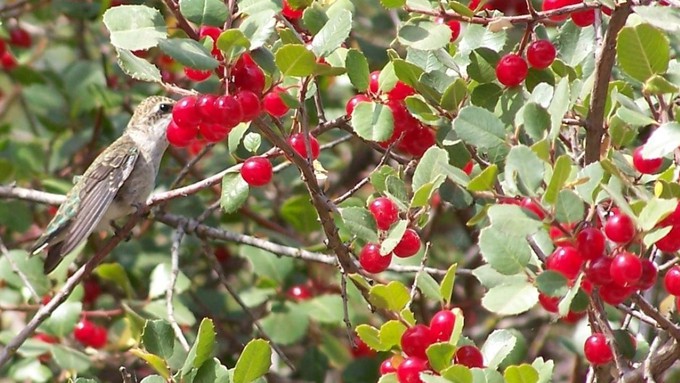
Learn how at free garden talks at all seven Green Acres

Hummingbirds like native plants, too. An Anna’s hummingbird pauses on a hollyleaf redberry in Sacramento to eat some insects. Photo courtesy Sacramento Valley CNPS
Pollinators make the world a more bountiful place; without them, we wouldn’t eat.
In addition to all those busy bees, favorite pollinators include butterflies and hummingbirds. While at work, these beneficial insects and active birds are fun to watch.
Learn how to invite more wildlife into your yard during free talks Saturday morning, June 17, at all Green Acres Nursery & Supply locations.
Set for 10 a.m. Saturday, “Grow a Butterfly and Hummingbird Garden” will cover the basics of how to plant a pollinator-friendly space for this summer’s visitors as well as how to attract more butterflies and hummingbirds for years ahead.
Plant the right flowers and they will come. Different species prefer to feed on specific plants.
According to the Sacramento Audubon Society, six species of hummingbirds may be seen in our region. They all love trumpet-shaped flowers, preferably in bright red or orange colors.
With emerald green feathers and a ruby-pink throat, Anna’s hummingbird is the most common – and a permanent Sacramento-area resident. Unlike most hummingbirds, Anna’s Hummingbird doesn’t migrate and is very territorial.
According to the Cornell Lab of Ornithology, Anna’s hummingbird is crazy about eucalyptus trees; the widespread planting of eucalyptus in California also spread the distribution of these tiny birds. In the wild, they feed on the nectar of manzanita, currant and gooseberry flowers but also go for lots of backyard plants. (Hummers also like to eat small bugs.)
Butterflies prefer flowers that offer a landing platform – some place to sit while they snack. Daisy-like flowers such as asters, coneflowers, lantanas and zinnias attract a wide range of butterflies but so do native plants such as California buckeye.
Some species demand certain plants for breeding. Monarchs must have milkweed. As their name implies, pipevine swallowtails lay their eggs on California pipevines. Purple passion flower vines host the Gulf fritillary. (Just remember: Butterfly host plants are grown to be eaten by caterpillars. So expect holes in the leaves!)
Find out who likes which flowers and a lot more during these information talks, which also provide an opportunity to get some local expert planting recommendations.
Green Acres nurseries are located in Sacramento, Auburn, Citrus Heights, Elk Grove, Folsom, Rocklin and Roseville.
For addresses and directions: https://idiggreenacres.com/.
Comments
0 comments have been posted.Sacramento Digs Gardening to your inbox.
Sites We Like
Garden Checklist for week of July 21
Your garden needs you!
* Keep your vegetable garden watered, mulched and weeded. Water before 8 a.m. to reduce the chance of fungal infection and to conserve moisture.
* Feed vegetable plants bone meal, rock phosphate or other fertilizers high in phosphate to stimulate more blooms and fruiting. (But wait until daily high temperatures drop out of the 100s.)
* Don’t let tomatoes wilt or dry out completely. Give tomatoes a deep watering two to three times a week.
* Harvest vegetables promptly to encourage plants to produce more. Squash especially tends to grow rapidly in hot weather. Keep an eye on zucchini.
* Pinch back chrysanthemums for bushy plants and more flowers in September.
* Remove spent flowers from roses, daylilies and other bloomers as they finish flowering.
* Pinch off blooms from basil so the plant will grow more leaves.
* Cut back lavender after flowering to promote a second bloom.
* It's not too late to add a splash of color. Plant petunias, snapdragons, zinnias and marigolds.
* From seed, plant corn, pumpkins, radishes, winter squash and sunflowers.